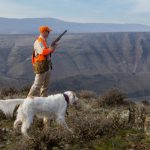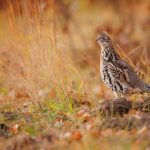Western Wings: California Quail in the Golden State
Editor’s Note: This article was published in the January/February 2022 issue of The Pointing Dog Journal, but under the incorrect byline of Don Thomas. Chasing California quail in California was written by our good friend Dave Smith, with photo support from Larry Kruckenberg. Our apologies!
The warm rays of sunshine, bright blue skies, and green grass understory of California’s oak woodlands painted a winter picture so distinctly different in look and feel than that of my frozen home country in Montana.
I parked along the gravel road at the boundary of a state wildlife area in the foothills of the Sierra Nevada mountains. In a moment that usually stirs a range of hunting anticipation emotions, I scanned the landscape with a vibe of even-keeled enchantment – peaceful, relaxing, charming. Based on many years of hunting California – valley – quail in my youth, I instinctively knew that this trance would soon vanish with rapid tailbeats, burning thighs from scaling steep hills, and nerves shot to hell by swinging on quail zipping through quick gaps in the oaks. Yet the promise of the day was grand: The previous winter and spring had been exceedingly wet in the Sierra Nevada foothills, with December and January rains and the type of green-up that produces quail at dizzying levels. This was a good year, and we were in splendid quail country. If all went well, the relaxed fulfillment would return with a brace of beautiful California quail lined out on the tailgate by dusk.
My comrades unloaded their German shorthairs and we headed in opposite directions with a general plan of hunting from the fringes of the state land toward some nice ridges in the center. California quail can be much more accommodating when large coveys get scattered, so we figured it best to pinch from the extremes with the hope that our respective covey flushes, even if not productive, would result in singles and doubles scattered around the center of the property for some good dog work.
The first half-mile felt a little disjunct, probably because I hadn’t hunted quail in a couple of years. The oak woodlands were aflush with songbirds creating a serenade of strange yet delightful sounds. My bird identification skills were so rusty that I didn’t think long on that subject; instead, I focused on the rhythm of hiking, working up a sweat wandering through the oaks, gradually gaining elevation.
Finally, Choteau was on birds. I hustled up a gentle rise just in time for the day’s first explosion of quail, disappearing instantly through a maze of live oaks as I swung and missed, a heartbeat late. Good omen, though. We stayed after it another several hundred yards, then Choteau button-hooked into a grassy clearing and this time the covey flushed precisely as you draw it up – into the clear blue skies. I folded the first bird going right, a straggler flushed at my feet, and I dropped it with my second shot. Choteau made two nice retrieves, and I stuffed the warm birds in my game bag. Shots in the distance were indicative of similar fortune.
The next couple of hours constituted a lesson in frustration as we bumped three more large coveys, all of which zipped through the oak trees before I could get on them, save for a single quail that rocketed up for the heavens and I folded cleanly. Running through several rounds of not being quite quick enough, a humbling doubt crept in about my wingshooting ability. These quail were not lumbering pheasants flushing at close range from thick cattails into blue skies; they were darts through a tangle of branches.

Photo by Larry Kruckenberg
Finally, we came to an open grassy ridge with small clusters of brush, the type of place where one could shoot quail rather than just hear them flush! I decided to approach it from the bottom, climbing the hogsback ridge in a way that would afford shooting opportunities on flushes in either direction. A hundred yards up the hill, Choteau got birdy. My legs were burning, but this was the time to go. I crested a rise to a quail hunter’s dream: Twenty birds exploding at close range in all directions. The shots were easy, with quail sailing out over open grassland, and I doubled. We quickly gathered them up and continued up the hill. Fifty yards later, a single flushed, and I centered it. The pattern played out twice more, resulting in two more quail in the sack. At the saddle of two ridges with the afternoon sunk sinking, I called it good, drank some water, and laid down in the green grass with Choteau at my side.
The blue oak woodland stretched as far as I could see in any direction, leaving me with a single thought: On these stellar quail years, any avid upland bird hunter worth his or her salt should come West to chase California quail! The challenge, of course, is knowing when it’s good and knowing where to go in the Golden State.
When it rains, we have quail.
Talk to any quail biologist in the West very long and you will, unequivocally, hear the most used quote in the quail manager’s book. It’s both an oversimplification that doesn’t capture all the factors that influence quail populations – namely habitat changes over time – and it’s the single most important consideration in making decisions on a road trip to the West to hunt California quail.
California’s quail populations and hunting opportunities have been dramatically reduced by subdivision, declining access to private lands, and an array of landscape changes that have resulted in habitat loss. The downward trend is shocking. In 1970, California had a population of roughly 20 million people, and the California Department of Fish and Wildlife (CDFW) estimated that hunters harvested 2.02 million quail that season. In 2020, the human population had nearly doubled to a total of 39.5 million people, and CDFW estimated that hunters harvested about 275,000 quail (78 percent California quail). That’s the bad news: The quail harvest in California is a tiny fraction of what it was 50 years ago.
The good news is that a wet year in the Golden State offers fabulous California quail hunting. CDFW estimates that hunters harvested 315,268 California quail during the 2018-’19 hunting season, 28 percent higher than 245,111 California quail taken in the 2016-’17 season. The spike of 70,000 more quail harvested within a couple of years is telling of the importance of annual weather patterns! When it rains, we have quail. Take that factor seriously in planning a trip.
California quail are widely distributed across the state, from the deserts along the Mexico border, to the coastal and Sierra Nevada foothills, to the sagebrush shrublands of northeastern California. So, where to focus? Unless you have private land access, which is hard to come by in California, the answer comes in two parts: (1) good habitat with decent amounts of public land; and (2) where it rained the previous winter.

Photo by Larry Kruckenberg
CDFW’s Upland Game Bird Harvest Survey report, published about every other year and available on the Upland Game Bird page of the CDFW website, is a great place to start. Looking back at the last few years, it provides a good picture of quail populations and hunting opportunities. The recent trend is that much of the state’s harvest comes from the southern half of the state. Quail populations are strong from Monterey County of the Central Coast south all the way to San Diego County. Likewise, good numbers of quail occur from eastern Kern County to Inyo County and southeast to the Mojave Desert. Finally, the oak woodlands of the Sierra Nevada foothills from Yuba County to Tehama County and chapparal habitats of the coast range on the west side of the Central Valley can offer excellent quail hunting in good years. The key to public land quail hunting is to focus on Bureau of Land Management (BLM) lands, the lower reaches of the National Forests, and state lands including CDFW Type C Wildlife Areas that allow hunting. Each of these regions can offer exceptional or very tough quail hunting in a given year, but the top quail harvest counties are indicators of good quail habitat.
Drilling down with some specifics on a logical starting point: Kern County has long been the number one county for California quail harvest, comprising 18 percent of the state’s total harvest in the 2020-’21 hunting season. Most of Kern’s good quail hunting occurs on mid-elevation creosote bush scrub BLM lands in the extreme eastern portion of the county, south of Ridgecrest. The El Paso Mountains between Inyokern and Garlock support good populations of California quail on wet years. Likewise, the Jawbone Canyon area northeast of Tehachapi can be a solid bet in certain years, as can be the Rand Mountains. California quail are also associated low-elevation chaparral brush country in the lower reaches of the Sequoia National Forest south of Highway 178.
California quail hunting prospects fluctuate dramatically from year to year based on winter rains and green-up, so the single most important bit of planning is to intensively study the precipitation patterns from the previous year and contact the local CDFW biologist. When it’s good, it can be really good, so do your homework and enjoy California’s form of a winter wonderland in good quail country!

Photo by Larry Kruckenberg
What you need to know…
Season: September 16 – January 30 (Zone 3) and an early coastal quail season of September 25 – January 30 (Zone 2)
Limit: 10 per day, 30 in possession
Additional species: Mountain quail, Gambel’s quail
Non-resident licenses: Season – $184; or Two-Day – $53; an upland gamebird validation stamp ($11) is also required
Shotguns: 20-gauge choked IC/M is ideal
Loads: Nonlead ammunition is required when taking any wildlife with a firearm anywhere in California. Steel and bismuth, No. 6 or No. 7, are good options for quail.
Precautions for dogs: Rattlesnake precautions are important in that oak woodlands are typically also rattlesnake country.
Maps: Available from Bureau of Land Management, U.S. Forest Service, and California Department of Fish and Wildlife.
State agency link: https://wildlife.ca.gov/
Note: Wildfires have ravaged California in recent years, resulting in closures of National Forests and State lands that typically offer good quail hunting. If you are planning a trip, strongly consider December or January and check in with the land management agencies in advance.





